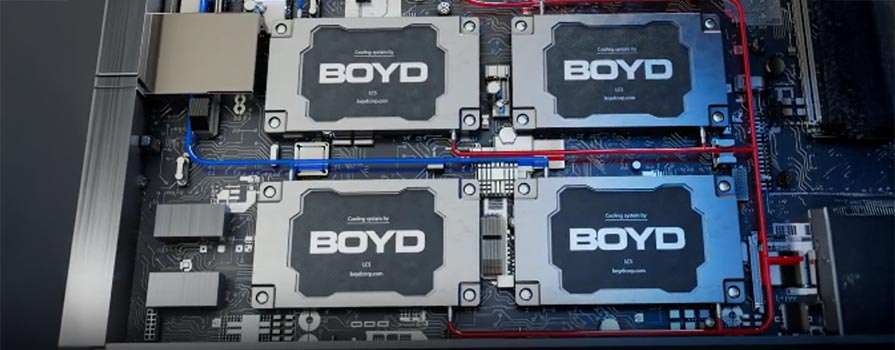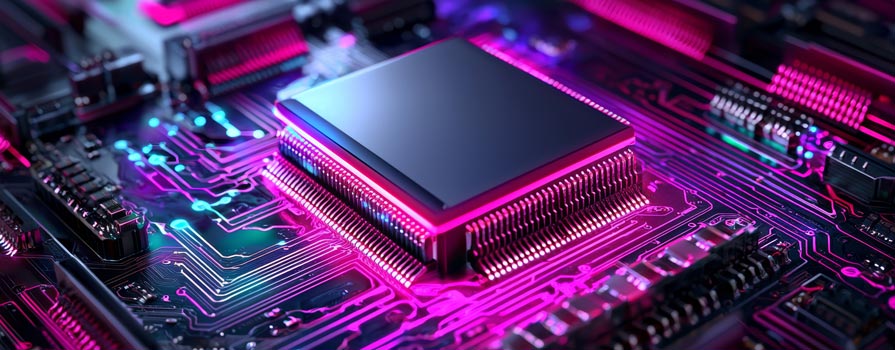Once you’ve determined liquid cooling is the solution, do you know what heat transfer fluid to use? One of the most important factors when choosing a liquid cooling technology for your application is the compatibility of the heat transfer fluid with the wetted surfaces of each part of liquid cooling loop. This includes liquid cold plates, heat exchangers, CDUs, tubes, and any quick disconnects.
Introduction to Common Liquids for Cooling Systems
Long-term liquid cooling system reliability depends on heat transfer fluid compatibility. Other heat transfer fluid requirements may include high thermal conductivity, specific heat, low viscosity, low freezing point, high flash point, low corrosivity, low toxicity, and thermal stability. Based on these criteria, the most commonly used coolants for liquid cooling applications today are:
- Water
- Deionized Water
- Inhibited Glycol and Water Solutions
- Dielectric Fluids

By selecting a compatible pairing of heat transfer fluid and wetted materials, you’ll minimize the risk of corrosion and optimize thermal performance.
Copper is compatible with water and glycol/water solutions.
Aluminum is compatible with glycol/water solutions, dielectric fluids, and oils.
Stainless steel is better for deionized water or other corrosive fluids because of its improved corrosion resistance over other metals.
Most cooling systems are compatible with water or glycol/water solutions but require specialized plumbing for deionized water or a dielectric fluid like polyalphaolefin (PAO).
Materials & Fluid Compatibility
| Metal | Water | Glycol | Deionized | Dielectric Fluids (Fluorinert, PAO) |
|---|---|---|---|---|
| Copper | X | X | X | |
| Aluminum | X | X | ||
| Stainless Steel | X | X | X | X |
Water as a Heat Transfer Fluid

Water is one of the best choices for liquid cooling applications due to its high heat capacity and thermal conductivity. It is also compatible with copper, which is one of the best heat transfer materials to use for your fluid path.
Facility Water or Tap Water
Water for liquid cooling comes from different sources. Tap water, for example, comes from a publicly owned water treatment facility or a well. The benefit to using facility or tap water is that it is readily available and inexpensive. What is important to note about facility water or tap water is that it is likely untreated and likely to contain impurities. Impurities can cause corrosion in the liquid cooling loop and/or clog fluid channels. Therefore, using good quality water is recommended to minimize corrosion and optimize thermal performance.
Water’s Potential for Corrosion
Water’s ability to corrode metal can vary considerably depending on its chemical composition. Corrosive chloride is commonly found in tap water. Facility or tap water should not be used in liquid cooling loops if it contains more than 25 PPM of chloride.
The levels of calcium and magnesium in the water also need to be considered. Calcium and magnesium can form scale on metal surfaces and reduce the thermal performance of the components.
Water Liquid Cooling Recommended Limit of Minerals
| Mineral | Recommended Limit |
|---|---|
| Calcium | < 50 ppm |
| Chloride | < 25 ppm |
| Magnesium | < 50 ppm |
| Sulfate | < 25 ppm |
| Total Hardness | < 100 ppm (5 grains) |
Deionized Water or Filtered Water
If your facility water or tap water contains a large percent of minerals, salts, or other impurities, you can either filter the water or purchase filtered or deionized water.
Corrosion Inhibitors: Phosphate, Tolyltriazole, and Organic Acids
We still recommend using a corrosion inhibitor for additional protection even if your facility or tap water is relatively pure and meets recommended limits. Phosphate is an effective corrosion inhibitor for stainless steel and most aluminum components. It’s also effective for pH control. One disadvantage of phosphate is that it precipitates with calcium in hard water. For copper and brass, tolyltriazole is a common and highly effective corrosion inhibitor. For aluminum, organic acids such as 2-ethyl hexanoic or sebacic acid offer protection.
Deionized Water
Deionized water is water that has had its ions removed, including sodium, calcium, iron, copper, chloride, and bromide. The deionization process removes harmful minerals, salts, and other impurities that can cause corrosion or scale formation. Compared to tap water and most other fluids, deionized water has a high resistivity. Deionized water is an excellent insulator which is ideal for electrical components manufacturing or immersion cooling where components bust be electrically isolated.

Corrosivity of Deionized Water
However, as water’s resistivity increases, its corrosivity increases as well. Deionized water is approximately pH 7.0 but will quickly become acidic when exposed to air. The carbon dioxide in air dissolves in the water, introducing ions and reduces the pH to 5.0. Corrosion inhibitors are required when using virtually pure water. When using deionized water in a recirculating chiller or CDU, special high purity plumbing are a must. The fittings should be nickel-plated and the evaporators should be nickel-brazed. When using deionized water in cold plates or heat exchangers, stainless steel tubing is recommended.
Pros to Deionized Water in Liquid Cooling Systems
Tap water meets the needs of most liquid-cooling applications. However, deionized (DI) water has chemical and electrical properties that make it the optimal choice for cooling when the liquid circuit contains micro-channels or when sensitive electronics are involved.
DI water has an extremely low concentration of ions which defines important performance attributes. First, it eliminates mineral deposits which block coolant flow which degrade cooling efficiency and system operating performance. Second, it eliminates the risk of electrical arcing due to static charge build-up from the circulating coolant. Arcing can damage sensitive control electronics in the cooled equipment. No ions in DI water eliminates both problems.
How to use Deionized Water in a Liquid Cooling System
Applications that need DI water are found in industries such as:
- Medical equipment
- Laboratory instrumentation
- Pharmaceutical production and food processing
- Cosmetic
- Semiconductor manufacturing
- Lasers, plating, chemical and other industrial processing
Exercise care when using DI water. The lack of ions makes this coolant unusually corrosive. Called the “universal solvent,” deionized water is one of the most aggressive solvents known. It will dissolve everything to which it is exposed to varying degrees. Therefore all materials in the cooling loop must be corrosion-resistant.
Copper’s Non-compatibility with Deionized Water
Copper and many other common materials are not compatible with DI water and will contaminate it. When you design a system using DI water, be sure to specify DI-compatible materials such as stainless steel or nickel.
Stainless Steel Wetted Paths for Deionized Water
In a heat exchanger or cold plate, we recommend a stainless steel fluid path. A DI friendly recirculating chiller should contain a nickel-brazed evaporator, a stainless steel pump head, and nickel-plated fittings. Finally, to maintain DI water purity, a deionization cartridge must be included. As with all consumables the DI cartridge must be replaced periodically.
In summary, many types of equipment and applications require DI water-cooled systems. When properly designed and maintained, these systems can provide reliable cooling and leak-free operation for many years.
Inhibited Glycol and Water Solutions in Liquid Cooling

The two types of glycol most commonly used for liquid cooling applications are ethylene glycol and water (EGW) and propylene glycol and water (PGW) solutions.
Ethylene Glycol and Water
Ethylene glycol has desirable thermal properties including a high boiling point, low freezing point, stability over a wide range of temperatures, and high specific heat and thermal conductivity. It also has low viscosity, meaning reduced pumping requirements. Even though EGW’s thermal conductivity is not as high as water it provides freeze protection that can be beneficial during use or shipping.
Propylene Glycol and Water
Although EGW has more desirable physical properties than PGW, propylene glycol/water is used in applications where toxicity might be a concern. PGW is generally recognized as safe for use in food or food processing applications and can also be used in enclosed spaces.
Automotive Ethylene Glycol and Water
Ethylene glycol is used in automotive antifreeze. However, automotive glycol should not be used in a cooling system or heat exchanger because it contains silicate-based rust inhibitors. These inhibitors can gel and foul, coating heat exchanger surfaces and reducing their efficiency. Silicates have also been shown to significantly reduce the lifespan of pump seals.
Choosing the Right Rust Inhibitor for Glycol and Water Solutions
While the wrong inhibitors can cause significant problems, the right inhibitors can prevent corrosion and significantly prolong the life of a liquid cooling loop. Inhibited glycols can be purchased from specialized fluid production companies and are highly recommended over non-inhibited glycols.
Glycol Concentration
As the concentration of glycol in the solution increases, the thermal performance of the heat transfer fluid decreases. Use the lowest possible concentration of inhibited glycol necessary to meet your corrosion and freeze protection needs. Dow Chemical recommends a minimum concentration of 25-30% EGW4. At this minimum concentration, ethylene glycol also serves as a bactericide and fungicide. With recirculating chillers, a solution of 30% ethylene glycol will result in only about a 3% drop in thermal performance over using water alone but will provide corrosion protection as well as freeze protection down to -15°C (5°F).
Water Quality in Glycol Solutions
The quality of the water used in the glycol solution is also important. The water should meet or exceed the limits specified in the Recommended Mineral Limit table, even if you’re using an inhibited glycol. Ions in the water can cause the inhibitor to fall out of solution, resulting in fouling and corrosion.
Adding Glycol into your Liquid Coolant

When Is It Necessary to Add Glycol in Your Coolant?
Boyd recommends using a 30/70 glycol-water mixture with its recirculating chillers whenever the coolant temperature set point is below 10°C (48°F). Glycol lowers the freezing point of the mixture *(Figure 1). Adding glycol to your coolant reduces the freezing point of the coolant to around -34°C, preventing any risk of damage to your chiller caused by freezing.
Glycol does not transfer heat as well as pure water (Fig. 2 & 3). So if there is no risk of freezing, use 100% water as adding glycol to your system will decrease performance. However, when the set point is below 10°C (48°F) there is a risk of freezing and Glycol should be added to water. The slight decrease in performance is a necessary trade-off to safely allow the lower temperature set point.


How Coolants Work in Chillers
In a recirculating chiller, the liquid coolant flows through the application, removing excess heat and raising the temperature of the liquid. This coolant then needs to be returned to set point temperature by flowing through a heat exchanger called the evaporator.
Learn more about Compressor-Based Refrigeration.
The heat exchanger transfers heat between the liquid coolant and the system’s refrigerant gas. The refrigerant’s temperature must be lower than the temperature of coolant liquid for heat to flow and for coolant temperature to be effectively returned to set point.
The temperature of the refrigerant is typically 5°C to 10°C lower than coolant temperature to allow heat to flow. Consequently, if the temperature set point is below 10°C (48°F), the refrigerant’s temperature can be close to, or even below the freezing point of water. If the coolant freezes, the evaporator can become obstructed, preventing water flow. Water expands as it freezes, which can permanently damage the evaporator.
Dielectric Fluids
Power electronics, laser, and semiconductor industries might be more likely to choose dielectric fluids over water. A dielectric fluid is non-conductive and preferred over water when working with sensitive electronics.

Perfluorinated Carbons as a Heat Transfer Fluid
Perfluorinated carbons, such as 3M’s dielectric fluid Fluorinert™, are non-flammable, non-explosive, and thermally stable over a wide range of operating temperatures. Although deionized water is also non-conductive, Fluorinert™ is less corrosive than deionized water and therefore may be a better choice for some applications. However, water has a thermal conductivity of approximately 0.59 W/m°C (0.341 BTU/hr ft °F), while Fluorinert™ FC-77 has a thermal conductivity of only about 0.063 W/m°C (0.036 BTU/hr ft °F). Fluorinert™ is also much more expensive than deionized water.
Polyalphaolefin Liquid Cooling
PAO is a synthetic hydrocarbon used frequently in defense and aerospace applications for its dielectric properties and wide range of operating temperatures. For example, the fire control radars on today’s jet fighters are liquid cooled using PAO. Boyd has PAO compatible recirculating chillers for testing cold plates and heat exchangers that will use PAO in their final application. PAO has a thermal conductivity of 0.14 W/m°C (0.081 BTU/hr ft °F). Although dielectric fluids provide low risk liquid cooling for electronics, they generally have a much lower thermal conductivity than water and most water-based solutions.
Selecting Your Heat Transfer Fluid

Water, deionized water, glycol/water solutions, and dielectric fluids such as fluorocarbons and PAO are the heat transfer fluids most commonly used in high performance liquid cooling applications. It’s important to select a heat transfer fluid that is compatible with your fluid path, offers corrosion protection or minimal risk of corrosion, and meets your application’s specific requirements. With the right chemistry, your heat transfer fluid can provide very effective cooling for your liquid cooling loop.
For more information on liquid cooling technologies and the proper working fluid to use in your system, contact us.






